Thursday Dec 25, 2025
Thursday Dec 25, 2025
Thursday, 8 September 2022 00:30 - - {{hitsCtrl.values.hits}}
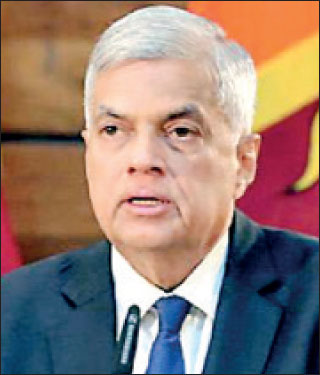
Despite his well-deserved reputation for ruthlessness, President Wickremesinghe is politically weak
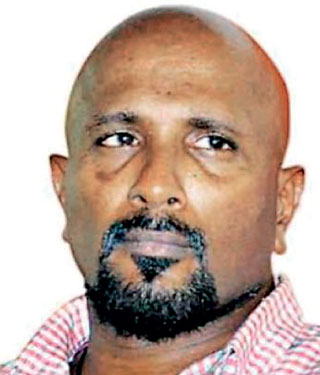
Kumar Gunaratnam
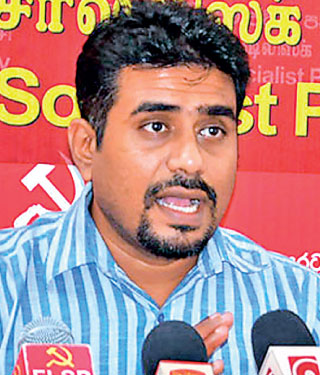
Duminda Nagamuwa
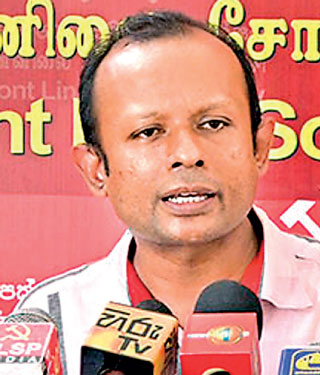
Pubudu Jayagoda
|
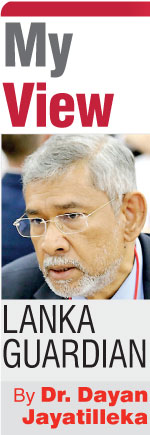 Sri Lanka was “the bloodiest place on earth, with the possible exception of El Salvador”, wrote The Economist (London) in 1989. The island’s slide into hell began with a single lie that the JVP perpetrated the anti-Tamil violence of July 1983 and consequently should be proscribed. It was uttered by the UNP Government of President Jayewardene of which Ranil Wickremesinghe was a hawkish young Minister, and first articulated publicly by Minister Ananda Tissa de Alwis. Only Prime Minister Premadasa and Finance Minister Ronnie de Mel dissented in Cabinet.
Sri Lanka was “the bloodiest place on earth, with the possible exception of El Salvador”, wrote The Economist (London) in 1989. The island’s slide into hell began with a single lie that the JVP perpetrated the anti-Tamil violence of July 1983 and consequently should be proscribed. It was uttered by the UNP Government of President Jayewardene of which Ranil Wickremesinghe was a hawkish young Minister, and first articulated publicly by Minister Ananda Tissa de Alwis. Only Prime Minister Premadasa and Finance Minister Ronnie de Mel dissented in Cabinet.
Now, a UNP President, a member of the post-1977 Cabinet, is doing it again.
Framing the FSP
Addressing the 76th Convention of the UNP, President Wickremesinghe told his audience and the nation (through the TV newscasts) that:
“…From within the Aragalaya, putting violence at the forefront, the Peratugameen [Peratugamee Samaajawaadee Pakshaya, Frontline Socialist Party] took the lead…From July 9th to July 14th they tried to capture power including Parliament…”
President Wickremesinghe must be inhabiting another dimension, the ‘Upside Down’ of the Netflix series ‘Stranger Things’. The country and the world witnessed the Aragalaya, Frontline Socialist Party and all, on TV and social media. The FSP did not fire a single shot nor wielded a single firearm or lethal weapon. Nobody died violently at the hands of the FSP or the Aragalaya in Colombo where the abortive power-grab was supposed to have taken place.
Those who died were demonstrators, almost certainly at the receiving end of State violence. The death of an MP at the hands of a provincial lynch mob was on 9 May, not 9-14 July. On 13 July, the closest the demonstrators got to Parliament, neither the FSP nor the IUSF were present.
From its inception in 2012 up to and including the Aragalaya, and with or without the IUSF within which its ideological influence preponderates, replacing that of the JVP, the FSP’s strategy and tactics have not belonged to the paradigm of armed revolution as did the JVP’s in 1971 and 1986-’89, but to that of a thoroughly researched and voluminously documented global phenomenon, that of the ‘new social movements’, the markers of which date back to the World Social Forum and the anti-globalisation Seattle protests of 1998, through the 2008 Occupy Movement, to Black Lives Matter.
Even within that framework, the FSP (or if you prefer, the FSP/IUSF) has never resorted to rioting and looting of a sort that has punctuated and marred such protests throughout the world, including the USA. The counter-violence of 9 May in Sri Lanka, which featured some horrific actions (in none of which FSP engagement has been proved), did not contain rioting against commercial or State establishments.
On national TV talk-show panels, the leading FSP representatives are usually the most intelligent, analytical and informative. Also, they never yell.
If President Wickremesinghe has a shred of evidence to prove his very serious allegations against the FSP he should produce that evidence. When a President speaks like this it is usually a precursor of unjust folly to come. Perpetrated by an unelected leader during an unprecedented economic crisis, a frameup and suppression of the FSP can be “the single spark that starts the prairie fire” (Lenin, Mao).
Missing mandate
The IMF gets something really fundamental which the President and the Government do not. Responding to a question at the important press conference announcing the signing of the staff -level agreement with the Government of Sri Lanka (GoSL), Peter Breuer, Senior Mission Chief – Sri Lanka, IMF, said this:
“Q9: What is your assessment about Sri Lanka’s current political situation?
A: The political environment is crucial to successfully carry out economic reforms, as the government should have the mandate to implement the reforms. The country has regained its political stability to a greater degree now since the mission’s last visit in June 2022.”
While he correctly commends the greater degree of political stability that exists in the country now as compared to June 2022, he opens with a crucial observation that “the political environment is crucial” to the economic reforms. Even more significantly, he identifies that factor which is crucial to the political environment: “…as the government should have the mandate to implement the reforms”.
Wickremesinghe was elected/selected to the Presidency in Parliament by a ruling party against which the public was in rebellion because it had betrayed its own mandate, beginning with President Gotabaya Rajapaksa’s overnight, nationwide ban on synthetic fertiliser, weedicides and pesticides.
The ruling party certainly has no mandate to implement the IMF reforms, because it ran against Prime Minister Wickremesinghe who espoused policies akin to the current reforms.
Logically then, there is little chance of the successful implementation of the reforms. Those who wish to see the reforms go forward successfully should fight for a government with a popular mandate, i.e., for early Presidential and Parliamentary elections to ensure a measure of public buy-in when the reforms really bite, which will be sooner rather than later.
|
Neo-colonised at 75
Sri Lanka will be 75 years old as an independent country, six months from now. 13 years ago, we had come through, despite all our sins and follies since 1956 or 1948 and felt like we were on top of the world.
In May 2009 we had conclusively defeated a cyanide-capsule wearing, suicide-bombing terrorist army (with a navy and fledgling air-force), the world’s most powerful terrorist militia/formation, and less than 10 days later, won a convincing diplomatic victory at the UN Human Rights Council in Geneva. But as I predicted, we were in danger of winning the war and losing the peace (‘Long War Cold Peace’, Vijitha Yapa, Colombo, 2013, 2014).
The last 10 years have been Sri Lanka’s Lost Decade and it was lost under the Rajapaksas and Ranil Wickremesinghe. Now as we approach 75 as an independent nation, they are governing together.
Two months ago, on 9 July, the Sri Lankan people were at their most powerful and Sri Lanka was at its most vibrant: a democratic republic with the people collectively and actively asserting their sovereignty. Today, two months later, we have a worse inversion than Egypt after Tahrir 2, the ascendancy of Al-Sisi and the crackdown of the Tahrir generation activists which left more of them in jail than under Mubarak, their original target. At least General Al-Sisi got into a suit, ran for election and won. Not so Ranil Wickremesinghe.
With six months to go for Sri Lanka’s 75th Independence Day, this country is less free than it ever was since de-colonisation, in the two most fundamental respects, political and economic.
Politically, it is ruled by an unelected leader, who unlike President D.B. Wijetunga who stepped in after the assassination of President Premadasa, is also unelected to Parliament.
Economically, the most crucial decisions affecting the material lives and futures of Sri Lankans will no longer be taken in Sri Lanka or by Sri Lankans elected by the Sri Lankan people. They will be taken by a supranational organisation, the IMF, together with an unelected Sri Lankan leader and top bureaucrats.
Sri Lanka is no longer the epicentre of decision making about Sri Lankan lives. In the run-up to 75, this is the closest approximation to our colonial past, when decisions were made by Whitehall bureaucrats. Where we are right now, is the very model of neocolonialism.
|
Parliamentary Aragalaya
There is a sliver of silver in this black cloud. For a long time, the Rajapaksas and Ranil Wickremesinghe were the only alternatives to each other, but for the first time they are no longer so. In fact, they are conveniently cozied up in a single ruling bloc, which makes it easier to give them the heave-ho.
The Rajapaksa dynasty rested on the SLPP-led coalition and the SLPP as a party. The Ranil-Rajapaksa bloc rests on the SLPP. The SLPP-led coalition is long gone, with the double defection of the parent party the SLFP and the smaller parties that formed the Joint Opposition (JO). The orators of the MR comeback campaign are long gone too, and have just constituted themselves under Wimal Weerawansa’s leadership into the strangely-named Superior Sri Lanka Alliance (Uttara Sri Lanka Sandhaanaya). The most recent and perhaps consequential departure was the Dullas Alahapperuma-GL Peiris group of 12 MPs, newly named the Freedom National Congress. This was from the SLPP itself. The Freedom group consists of the brainy element of the ruling SLPP. Only the brawn and the crafty, malfunctioning familial lobe of the SLPP cortex are left.
It is irrelevant that those who have left the once-mighty SLPP-led ruling coalition are themselves splintered. What matters are what they hold in common and the numbers they have subtracted from the ruling coalition. What they share is an antipathy to the political dominance of a family oligarchy, the Rajapaksa clan, and its reckless trajectory to national ruin when there were other better pathways available. All these dissident formations are like so many guerrilla bands determined to de-Rajapaksa-ise the Centre-Left space.
As for the arithmetic, the ruling coalition is now far too close for comfort to dipping below the magic figure 113 which is all that’s needed for Parliament to vote for self-dissolution and thereby trigger a general election.
With a whiff of restorationism in the air, the swagger of the Rajapaksas has returned, it is but a delusion; a drunken last waltz. The first election, be it in 2023 or 2025, or a sub-national one this year and they are toast—electorally burnt to a crisp.
There will always be a centre-left space, however shrunken in Sri Lankan politics, but there’s no way the Rajapaksas and the pro-Rajapaksa barons of the SLPP, at the airport to greet their returning hero Gotabaya Rajapaksa, will constitute that centre-left.
President Gotabaya Rajapaksa has wrecked the Rajapaksas’ peasant support even in the South and it will take a generation at least before it can re-grow. President Wickremesinghe’s anti-SOE drive will finish off the Rajapaksas’ (residual) support among public servants.
The centre-left is far more likely to consist of the various dissident factions of the shattered SLPP alliance, especially if they are able to form a coalition.
In a welcome intervention at this crucial moment, Chandrika Bandaranaike Kumaratunga’s speech at the event to launch the Nava SLFP was a remarkable return to form.
|
Ranil’s realities
Ranil Wickremesinghe was tossed out by two SLFP Presidents of very different dispositions, CBK and Maithripala Sirisena. The reason for the rupture on both occasions was that the policies he insisted on went against the very grain of the SLFP. Sirisena lost control of the bulk of the SLFP because of his partnership with Ranil. With the SLFP, the Dullas-GL group, Wimal’s bloc, and the CBK-Welgama outfit carving out whatever’s left, post-fertiliser ban, of the SLPP vote-base, how long before the Pohottuwa pedestal begins to wobble under the Ranil presidency it installed?
The pro-Rajapaksa rightwing that was openly pro-Hitler may have found an approximation which is a composite: President Wickremesinghe plus Secretary/Defence Kamal Gunaratna (and his able advisors). Despite his well-deserved reputation for ruthlessness, President Wickremesinghe is politically weak. Not only is his prop, the SLPP, fissured and assailed by its former partners, but his big pitch to the main Opposition party, the SJB, dismally failed to produce the result he expected, of pulling that party over to his side or hiving-off its economic liberals.
Whatever chances of the SJB coming over were wrecked by Ranil’s repressive actions against the Aragalaya activists, the aggressiveness of his SLPP allies, the rude rhetoric of his two SJB defectors, and above all, the mood at the grassroots which would have shifted to the JVP had the SJB been co-opted by President Wickremesinghe.
If President Wickremesinghe thinks it would be superbly Machiavellian to suppress the JVP so as to enable the SJB ‘economic Right’ to drag the whole party into propping him up, he would find he has been too clever by half. Firstly, the JVP-JJB is far too large to suppress. Secondly, a crackdown would either drive the JVP underground or cause its militants at the grassroots to defect to the more radical and militant FSP. Thirdly, the gap led by a suppressed JVP would be filled by the SJB which would be more populist than it is now, so as to attract JVP-JJB voters. Conversely, if he were to suppress the FSP so as to remove the pressure of competition from the JVP-JJB and make it more moderate, he would experience the reverse effect as the JVP moves further to the radical left, to attract stranded FSP supporters.
President Wickremesinghe is running out of options. He has one remaining, which was signalled by Kumar Welgama at the launch of his new party: declare a Parliamentary election in February-March 2023 and work with whoever is elected, which for sure won’t be the Rajapaksa SLPP. It might have worked but it won’t, because by that time, the IMF program, overloaded by Ranil’s own polarizing neoliberal policy baggage, would have generated such a social backlash that whoever wins a majority at the next Parliamentary election would have had to pledge to reverse, retard or overturn Ranil’s policies, shunning his leadership.
The speeches in the parliamentary debate on the interim Budget showed that there are two major options (in no particular order) at the next national elections, presidential and parliamentary: the centrist-populism of Sajith Premadasa’s SJB and the left-populism of Anura Kumara Dissanayake’s JVP-JJB.
The SLFP, the SLPP’s dissident Dullas-GL caucus, Wimal’s grouping, Welgama’s outfit, Champika’s 43 Group, etc. will have to compete with each other initially to lead a center-left bloc and then use it as leverage to enter a coalition with the SJB or JVP-JJB, either before or after an election.
The Tamil parties will have to choose between (1) a ticket on the Titanic with Ranil, (2) a return to the agreement with the Dullas-Sajith duo, and (3) a bet on the JVP-JJB.
Given that the Hartal 1953 was the first Aragalaya and the rightwing UNP hawk Sir John Kotelawala was the precursor of Ranil Wickremesinghe, the next election will be a 1956 on steroids (minus the Sinhala chauvinism). That is, if a fusion of the Aragalaya and the Hartal doesn’t pre-empt an electoral endgame.
|
SLPP Political Academy
Namal Rajapaksa was seen on TV news proclaiming that leaders cannot be produced by/through “Aragalayas (Struggles), Karali (Rebellions) and Prachandathvaya (Violence)”.
That’s political ignorance. The 35-year-old leftwing president of Chile, Gabriel Boric, rose from the “aragalaya” in the streets of Santiago three years ago. Gustavo Petro, the first ever leftwing president of Colombia is a former guerrilla of M-19. Pablo Iglesias, Spain’s Deputy PM a few years back, led the Spanish Occupy Revolt of 2011-2013.
That’s also hilarious. Namal was speaking at the convention of the TMVP of Pillaiyan, a former guerrilla commander who courageously rebelled first against the State and then against the LTTE. Young Rajapaksa’s pronouncements were against the backdrop of footage of armed LTTE or TMVP women fighters.